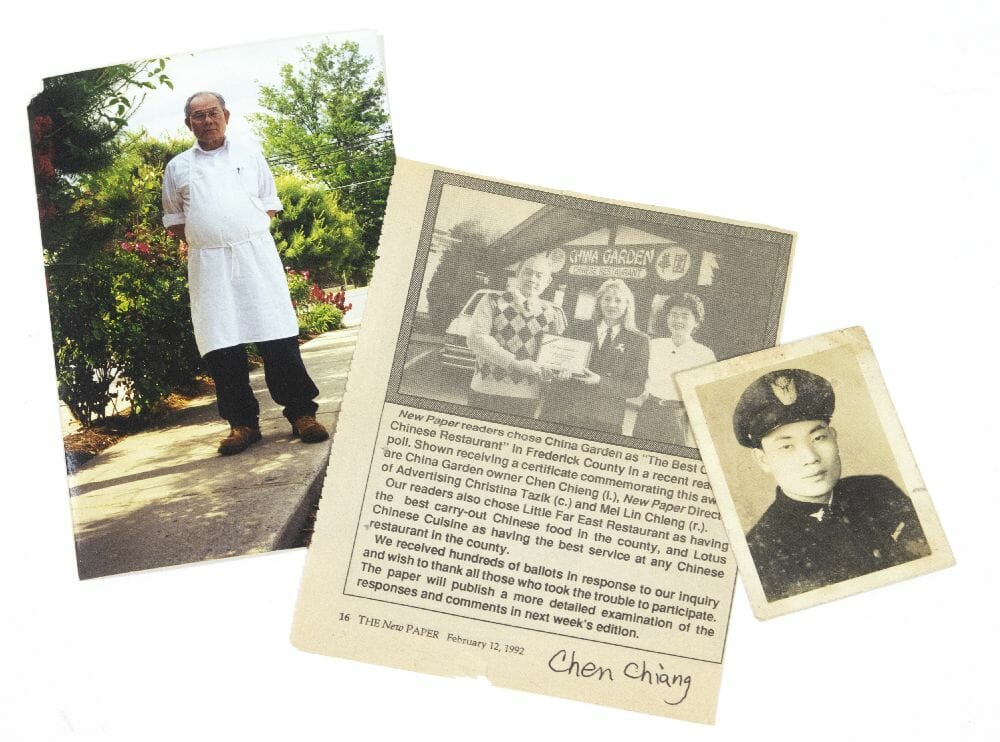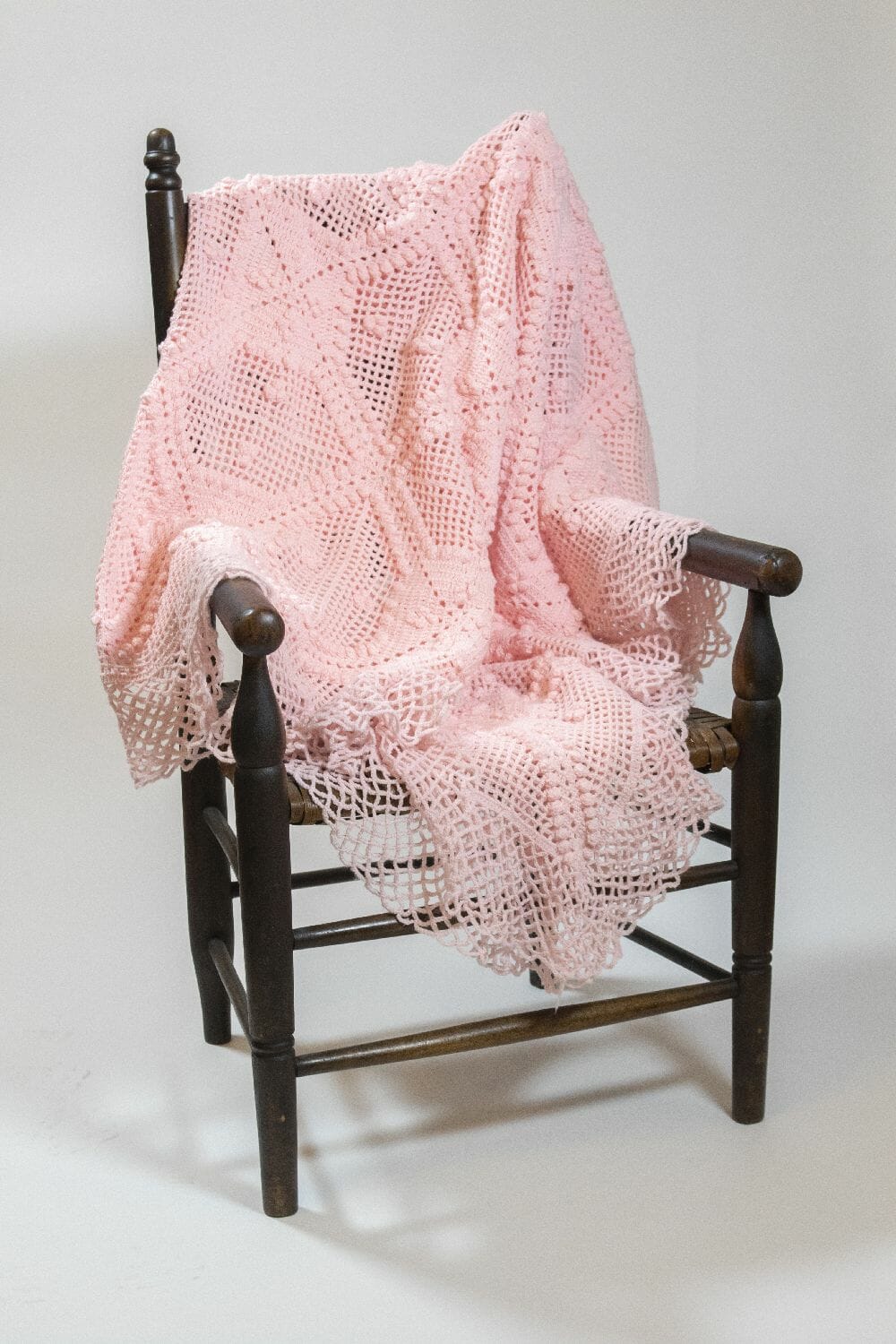
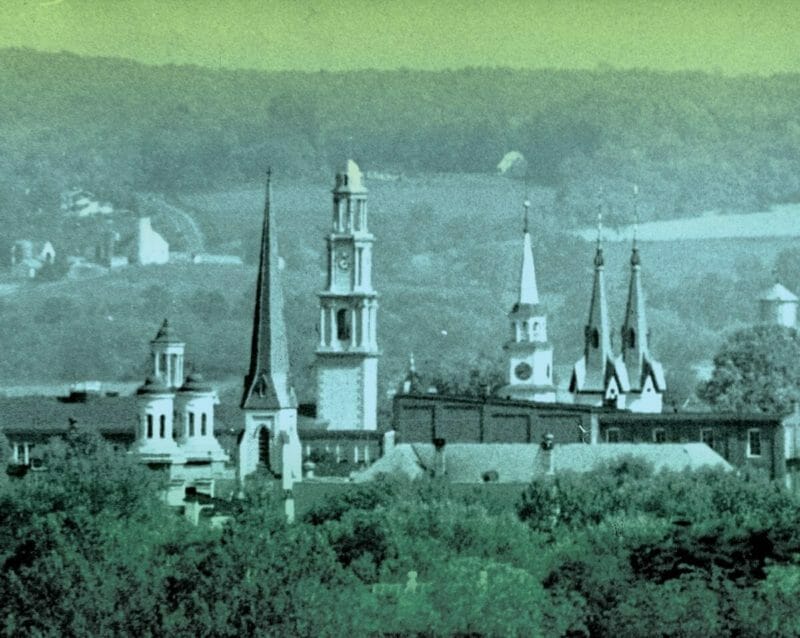
Frederick County has always been a crossroads. It’s allure to residents and visitors today is not much different from what captivated the Indigenous Peoples or the settlers from around the world who came here over the last 275 years. People have benefited from a scenic environment, ample natural resources, fertile lands, and the production of necessary goods and amenities.
A continual mosaic of people has created and re-created this unique and special place. Frederick County’s story goes on with authors that include new residents who arrive from neighboring counties, states, and countries from around the globe.
We the People highlights the impact and influence of the experiences of early inhabitants and settlers to Frederick and how the stories that modern immigrants have today aren’t all that different.

Indigenous Peoples
For thousands of years, native peoples traversed the land that would become Frederick County. Historic-era tribes, such as the Susquehannock, the Piscataway, and the Tuscarora used the Upper Potomac and Monocacy River and their surrounding valleys to hunt wild game, establish small encampments and villages, and establish trade routes.
Archaeologists have discovered dozens of habitation sites in Frederick County which preserve the remains of a vibrant Indigenous culture that existed for centuries before European colonization. These sites include settlements at Biggs Ford, Hughes Ford, and Mouth of Monocacy.
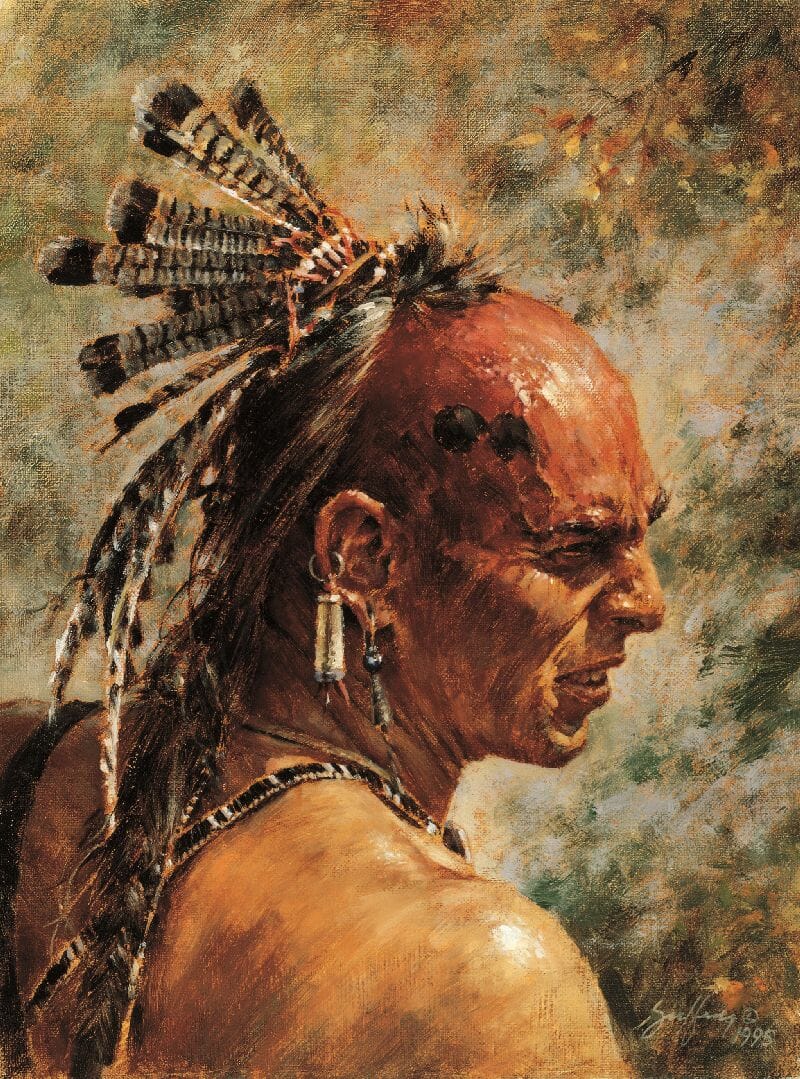
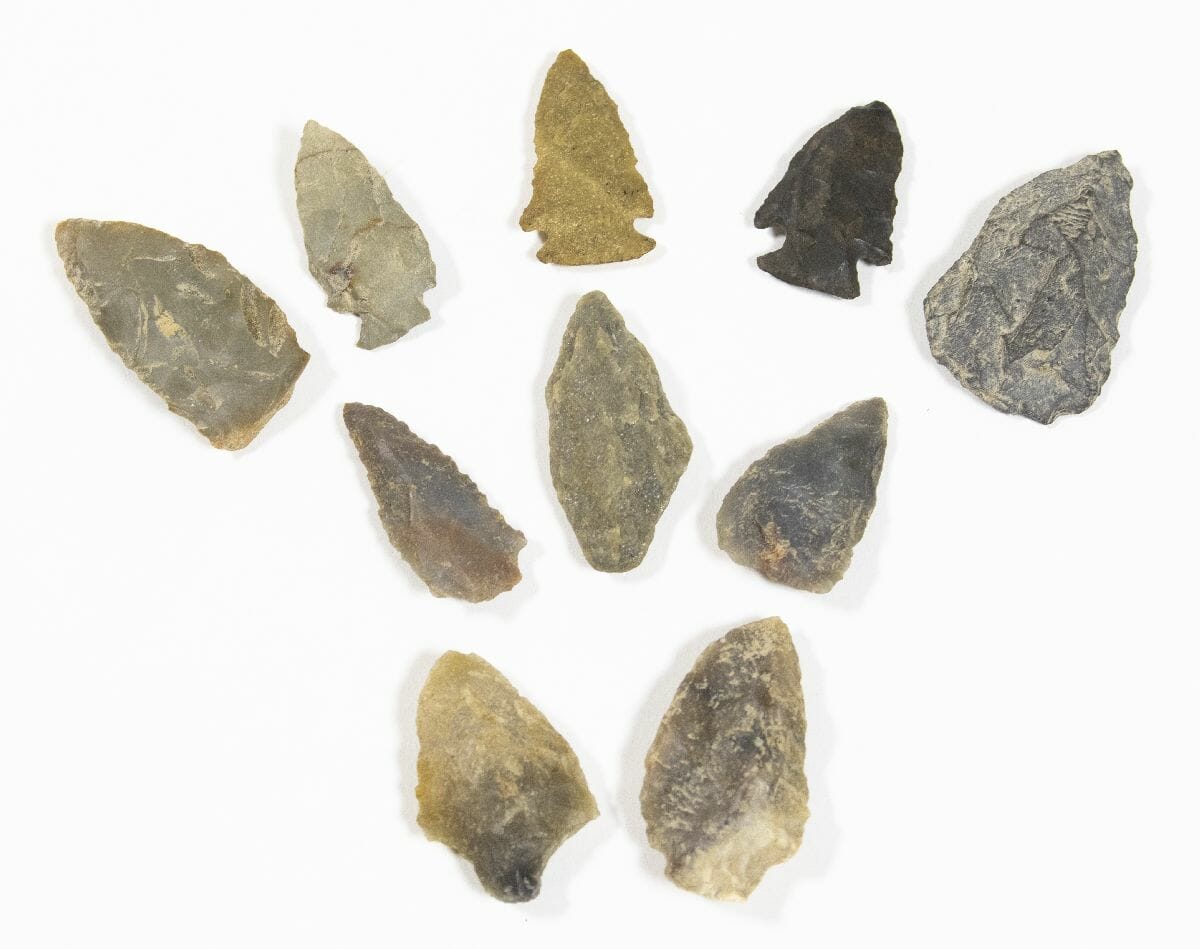
Spear Points
The Woodland Era spanned 1000-1,600. Settlements were established near rivers allowing for fishing and water transport. Villages formed as a means of protection. Far-reaching trade networks were established.
The bow and arrow was introduced in around 800 AD. The size of spear-points were made relative to the size of the animals that were hunted for food and clothing. These small arrow and spear-points document the craftsmanship of those who depended on the accuracy of their weapons.
Pottery Shards
Clay has been used for domestic ware, ritual tokens and decorative items since 28,000 BC . Generally found along rivers and streams, or where water once flowed, the right soil is composed of minerals, plant and animal life. Frederick County was a haven for this material and easily obtained.
Water softened the clay allowing shapes to be made. Simple decoration using a stick enhanced the beauty of the finished piece. Heating it in a pit with fire (firing) made the objects durable, not as durable as metal but certainly useful, necessary, and beautiful in every day life.


Early European Settlers
Locally, the earliest known European settlement was about 20 miles north of Frederick. English land speculators and colonial officials wanted to take further control of the area to make it profitable for themselves and the British crown.
One such developer, Daniel Dulany, an Irish lawyer and entrepreneur, had a land patent of 7,000 acres known as “Tasker’s Chance.” Dulany knew he could not successfully settle his new community on Maryland’s rough and untamed western frontier with English immigrants only. Pennsylvania had been successful in developing its unsettled interior lands with the help of German immigrants, known for being skilled, industrious, and brave. For several years, Dulany sent inducements to German and Swiss immigrants living in Pennsylvania as well as in Europe to settle on his Tasker’s Chance parcel. Meanwhile, English and Scots-Irish began migrating to the area, arriving from established towns and counties of the Maryland colony.
Immigration Trunk, circa 1750
Phillip Jacob Grundler and his family moved to America from Germany in 1754 using trunks like this one to pack their belongings. Sixty percent of Frederick County settlers came from other parts of the American colonies or from England. Approximately forty percent came from Germany, including the Grundlers.
The paper label inside the lid of the trunk reads: “Philip Jacob Gründler from Ostelheim on the R[h]ine was born July 21, 1702. In 1754 came to America and to Frederick was a member of the Lutheran Church. His daughter Christina Catherine, born at Ostelheim Sept. 11, 1738 died Jan. 20, 1849. Married John Hummel, born 1743 died Jan. 18, 1781, on August 18, 1771. Daughter Anne Catherine Hummel married John David Markey March 19, 1796.”
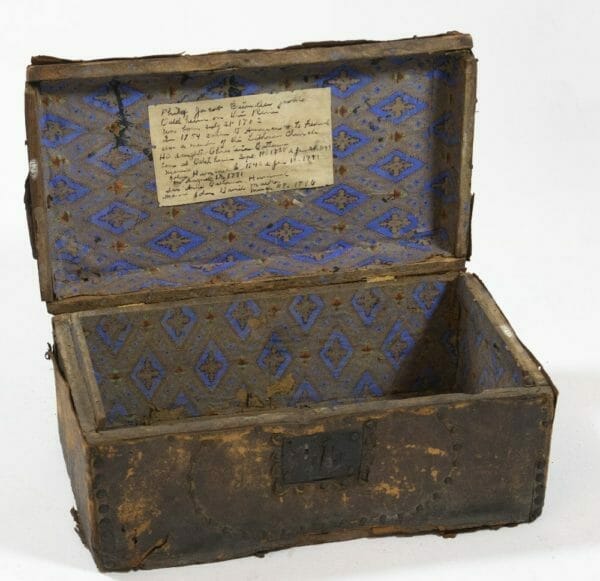
Plat of Frederick Town
Frederick Town was founded in 1745. In 1782, Samuel Duval created this plat, showing the early layout of the town.
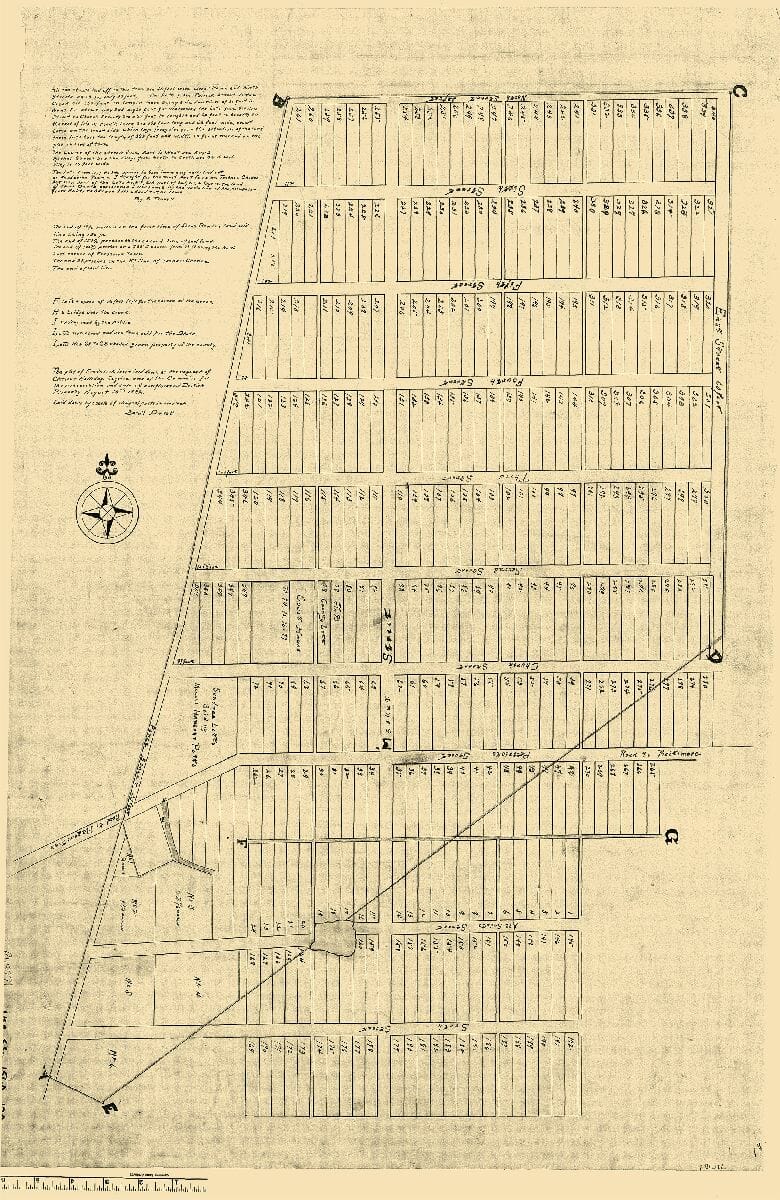
Colonial Life
In the New World, faith and frugality were guiding principles. Numerous churches were established in early Fredericktowne, which served for religious purposes, as well as centers for education and social life.
The distinct cultures of these early settlers were illustrated by the diverse architectural designs, styles of dress, cooking traditions and festivities. Many of these original congregations still exist in downtown Frederick today.
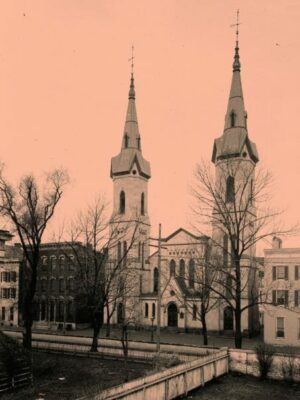
John Thomas Schley (1712-1790)
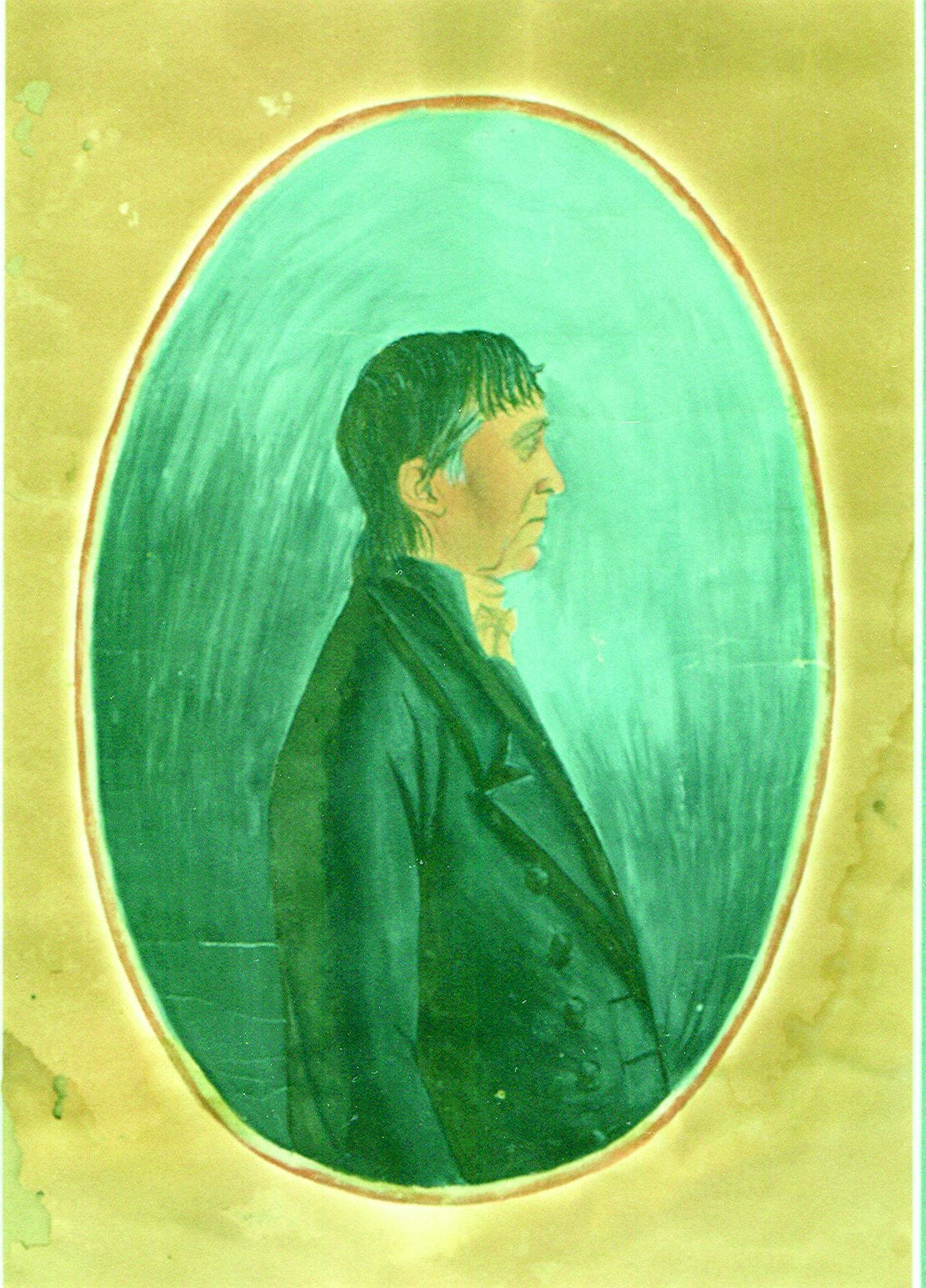
Born in Moerzheim, Germany, John Thomas Schley immigrated to Frederick in approximately 1745, and was among its earliest settlers. Schley (who is said to have built the first house in Frederick) was highly involved in the development of the town. Schley was a schoolmaster, tavern owner, organist and composer. He was also very active in the German Reformed Church (now Evangelical Reformed United Church of Christ). He was a founding member of Frederick’s first fire company. Schley became a naturalized citizen in 1760.


Revolutionary War
The American Revolution was the cause of a new and unexpected wave of Europeans to settle in Fredericktowne. Hessians, German mercenary soldiers from the Hesse region hired by the British to fight in the war, were captured in various battles and imprisoned in the Frederick Barracks in the south area of town. After finding friendly residents who shared their native German language, many Hessian soldiers made Frederick their home at war’s end rather than return to Europe.
The Frederick Barracks
The Frederick Barracks became known as the Hessian Barracks when the complex of buildings began to be used to imprison mercenary soldiers from Germany, 1780-1781. Thousands of Hessian soldiers who fought and lost in the battles of Yorktown, Saratoga, and Trenton were detained here. One of the Frederick Barrack remains, which has been preserved, remains on the grounds of the Maryland School for the Deaf. The outside of the building is open to the public.

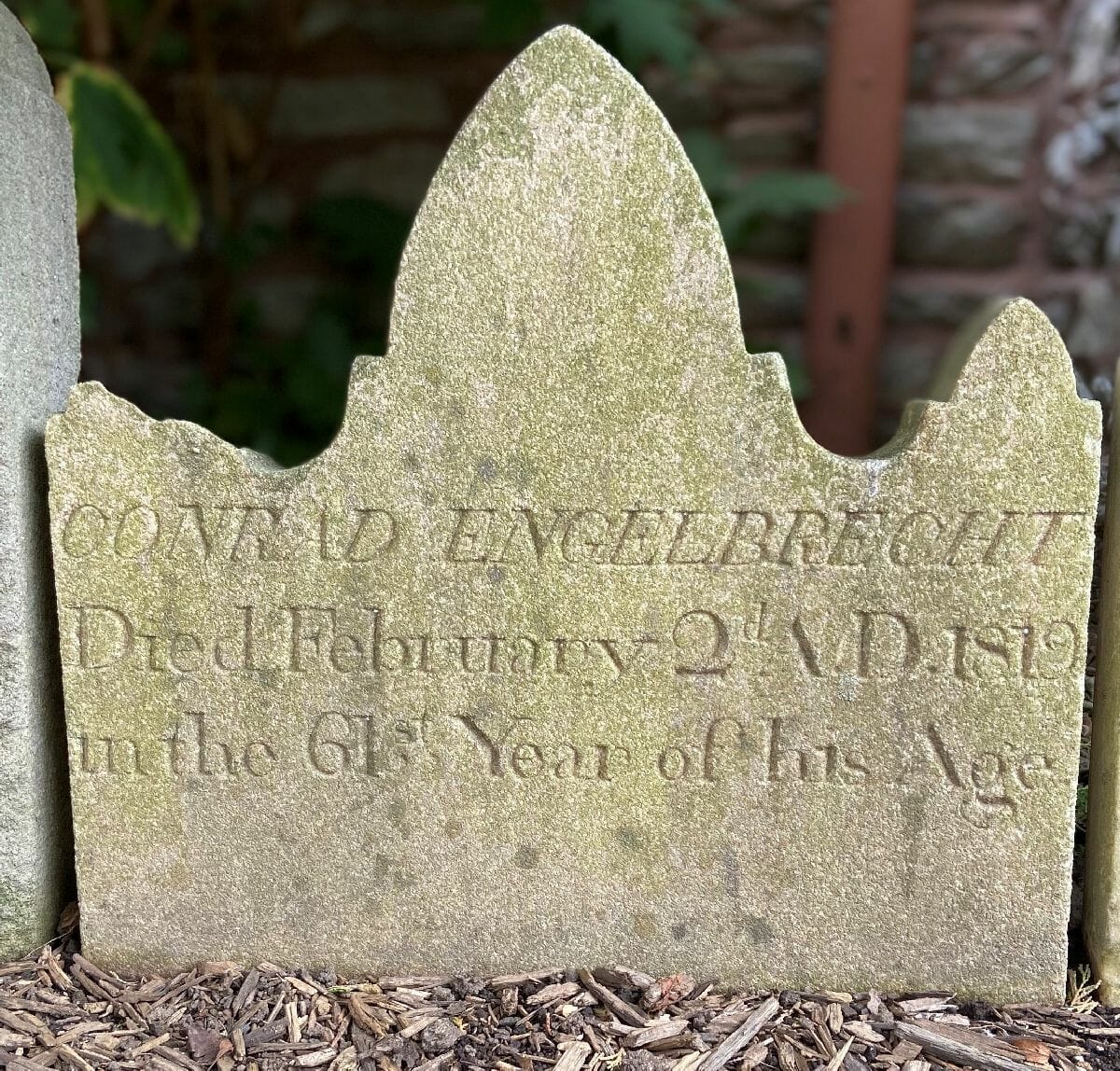
Conrad Engelbrecht (1758-1819)
A tailor from Eichig, near present-day Bayreuth, Germany, Conrad Engelbrehtt was one of the many Hessian soldiers hired by the British to suppress the Revolutionary War. Like others, Conrad Engelbrecht later established himself in Frederick. He was the father of Jacob Engelbrecht (1797-1878), a tailor, former town mayor, and musician, whose diaries written from 1818-1878 chronicle life in Frederick.
Conrad Engelbrecht (1797-1878)
Conrad’s son, Jacob Engelbrecht not only kept a diary, but he recorded history in his 20 tattered volumes, including details from marriages and deaths and from politics to his garden. He was a man of many occupations and hobbies that added to his entries. His meticulous entries for numbers were showcased as he counted the caravans of wagons passing his front door during the Civil War. He wrote in his father’s tongue which was a combination of archaic German, anglicized German, and misspelled German. Englebrecht’s sixty years of journaling provides the window of his life for us to enter.


Craftspeople Support Frederick
Fredericktowne became a thriving community that attracted many tradespeople, including weavers, tailors, silversmiths, shoemakers, tanners, blacksmiths, potters, and wheelwrights. As the town grew, these talented craftspeople helped establish Fredericktowne as a notable crossroads where makers of glass, furniture, clocks, jewelry, and hats could be found. Such locally made items contributed to the residents’ quality of life. One in seven citizens were tradesmen. The rest were farmers.
E. Frederick Klein (left) was born in Wurtemberg, Germany, in 1790. After serving as a baker in the army in Switzerland, he sailed to America and for two years worked as a baker in Pennsylvania. For 19 years he operated a bakery in Baltimore. Due to ill health, he moved to Frederick County in 1840.
Amelung Glass
In 1754, John Frederick Amelung (1741-1798) emigrated from Breman, Germany, to form his New Bremen Glass Manufactory in modern-day Urbana. From 1785-1790, the company employed hundreds of German immigrants to manufacture window panes, mirrors, optical glasses, sugar bowls, decanters, wine glasses, tumblers, and ornate presentation pieces for the new nation. Surviving Amelung glass artifacts are rare and highly collectable.
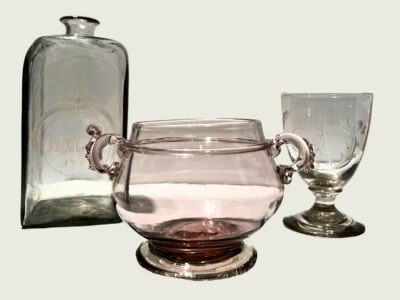
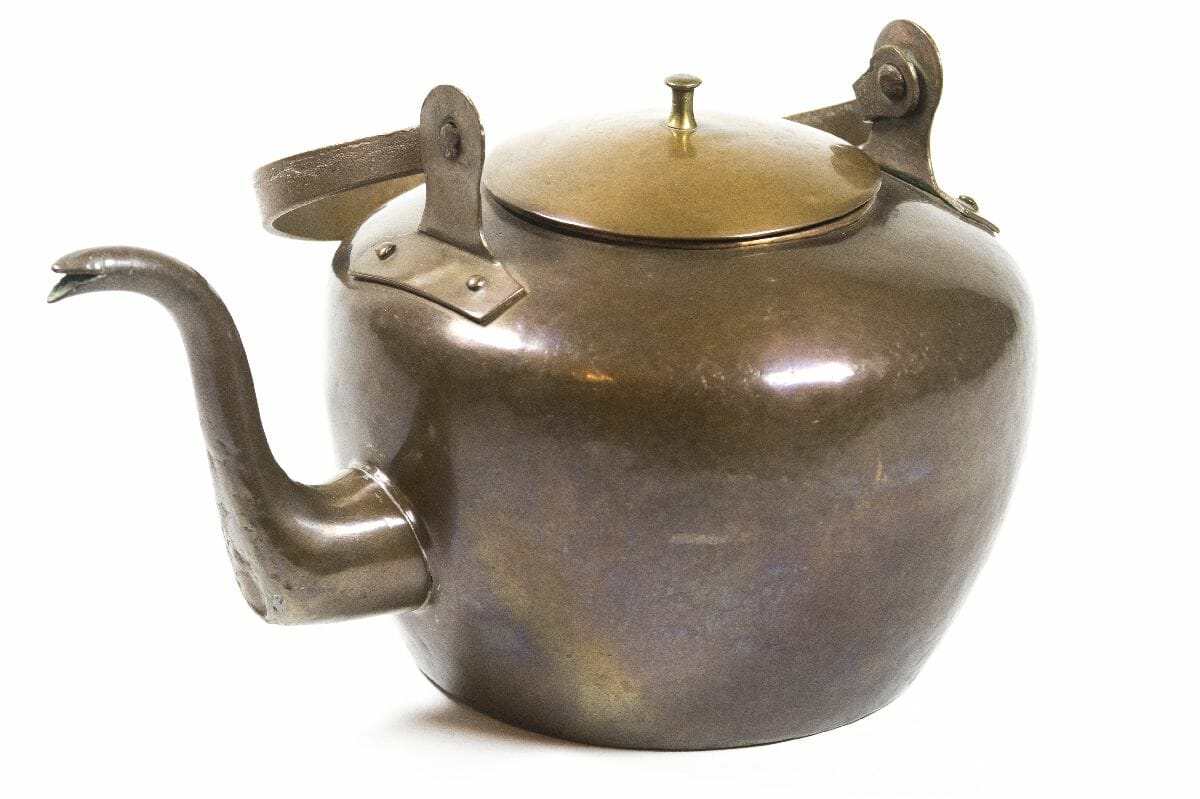
Matthias Zimmer’s Teakettle
It took many Frederick County citizens to produce this copper tea kettle ultimately made by German immigrant Matthias Zimmer (1749-1786) between 1770 and 1786. ZImmer’s apprentice, the copper miners, carpenters, and blacksmiths would have all been involved in the making of one teapot like this one. All supplies would have come from local forests, and mines.
Capt. Joseph Van Swearingen’s Pocket Watch
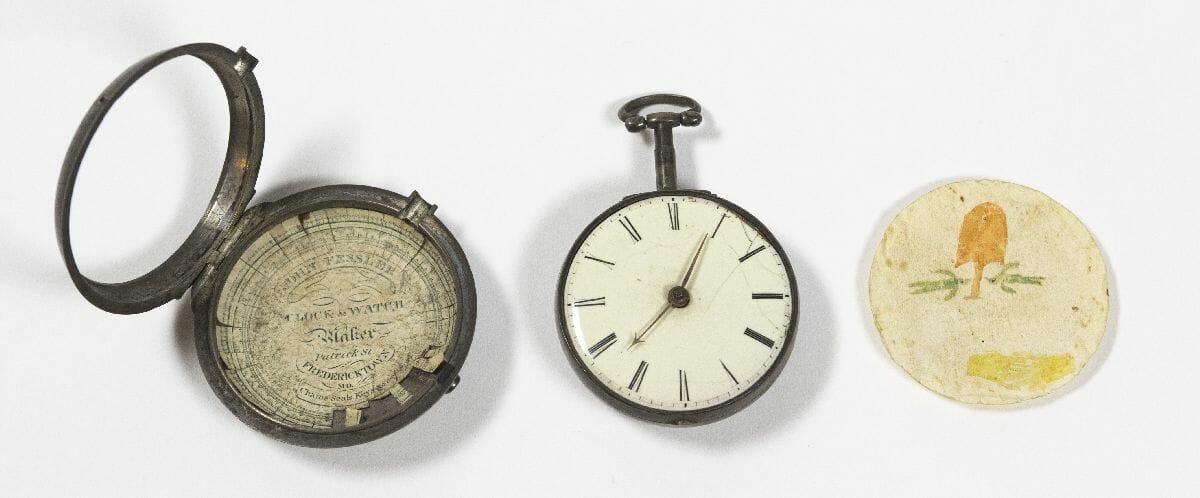
Captain Joseph Van Swearingen (1799-1837), a U.S. soldier from Middletown, owned this pocket watch, which was made in England between 1784 and 1815. It was repaired or sold by John Fessler (1759-1820), a Frederick silversmith and clocksmith who resided here from 1785 to 1820. Fessler emigrated from Switzerland and is known for his tall case (“grandfather”) clocks. He also produced silver dinnerware and repaired timepieces such as this one.
19th Century Immigrants
The B&O Railroad completed its Frederick Branch to Harper’s Ferry, Cumberland, and the Ohio River in 1831. Irish immigrants, escaping Ireland’s Hunger Famine of 1845-1853, worked for the B&O and other railroads. Many such laborers established themselves here, producing subsequent generations of railroad employees.
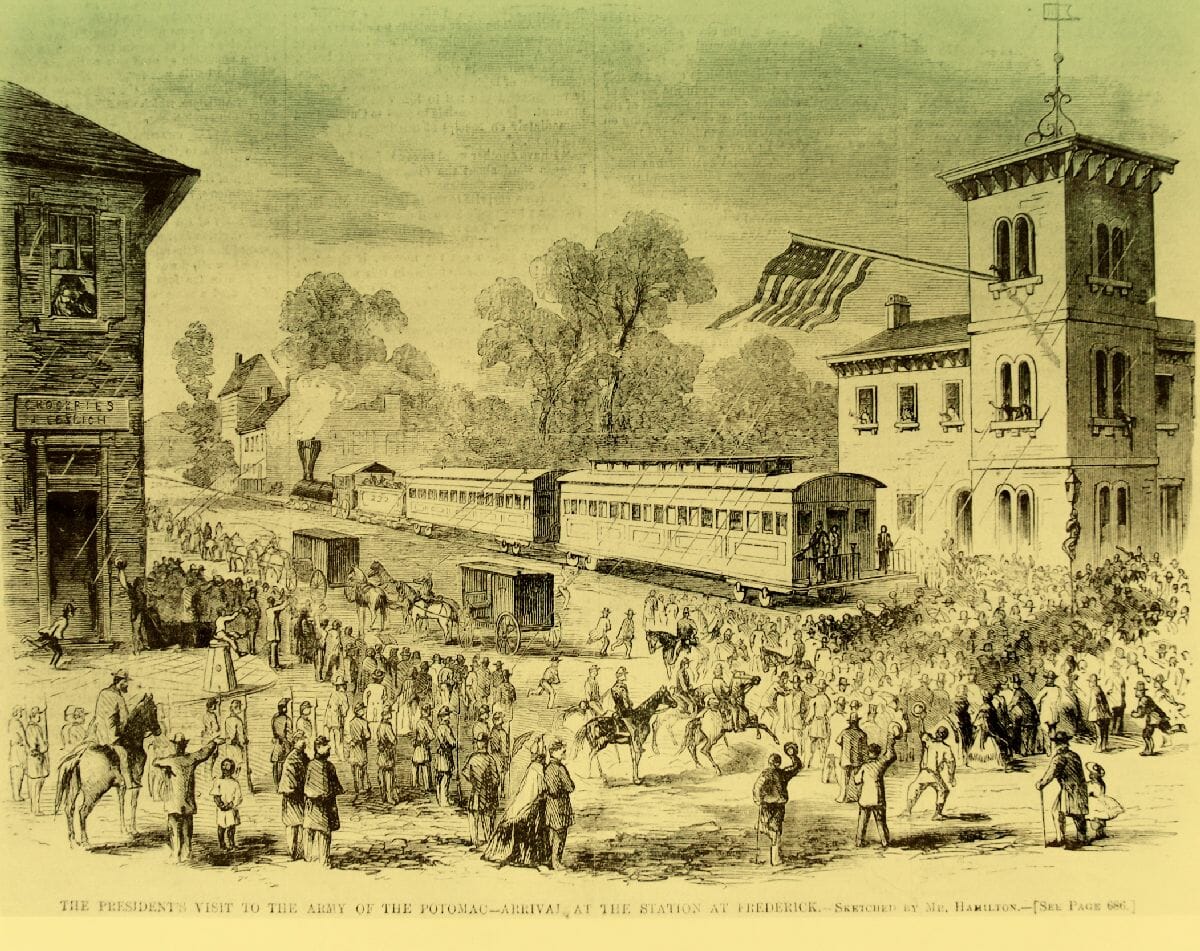
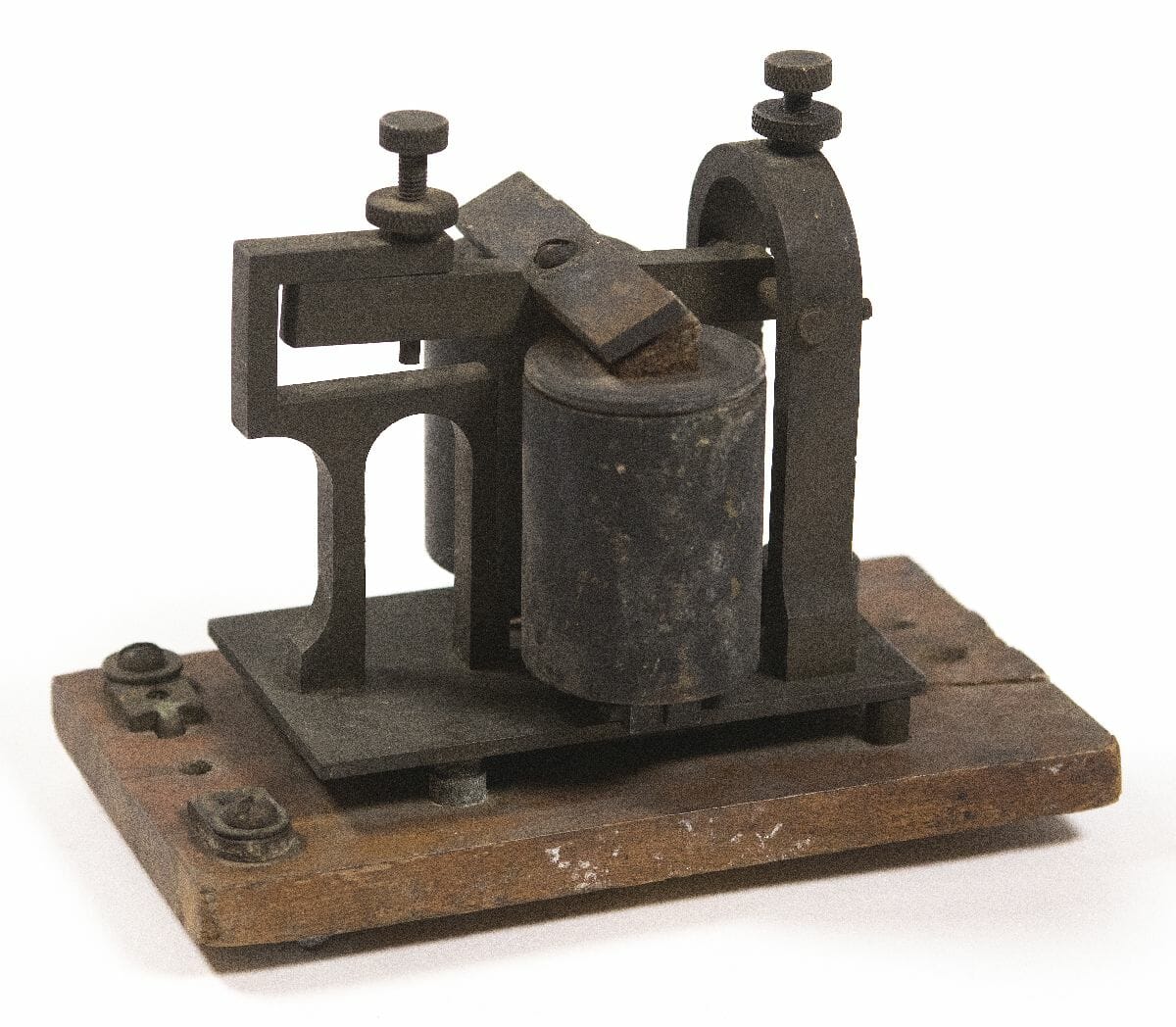
Telegraph Mainline Sounder
Prior to the invention of telephones, the telegraph provided efficient communication between railroad stations. Developed in 1850, the sounder used electromagnets to translate electrical current and allowed operators to “hear” Morse Code as a series of short and long tones, called “pips”.. This one came from the Frederick Passenger Station of the B&O Railroad.
20th Century Immigrants
Between 1880 and 1920, more than 20 million immigrants arrived in the U.S. seeking freedom and prosperity. The majority of immigrants were from Southern, Eastern, and Central Europe, including four million Italians and two million Jews. Frederick County’s population is continually evolving and each day a new chapter of its history is being written.
Dr. George Joseph (G.J.) Snowball, considered to be Frederick’s first black dentist, was born September 29, 1878 in Jamaica. He arrived in the United States on the S.S. Admiral Dewey. The ship’s passenger manifest, dated September 11, 1912, lists him as 33 years of age at that time. He established a local dental office several blocks from the Heritage Frederick museum and practiced for 57 years.
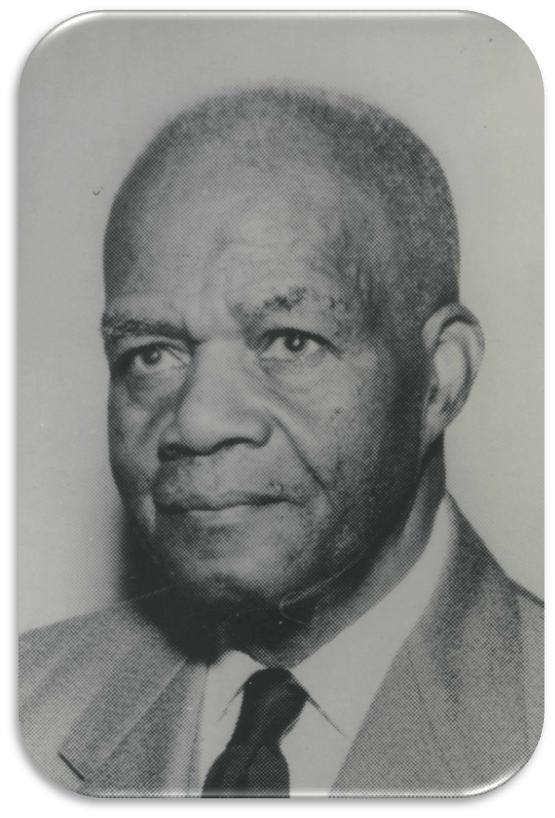
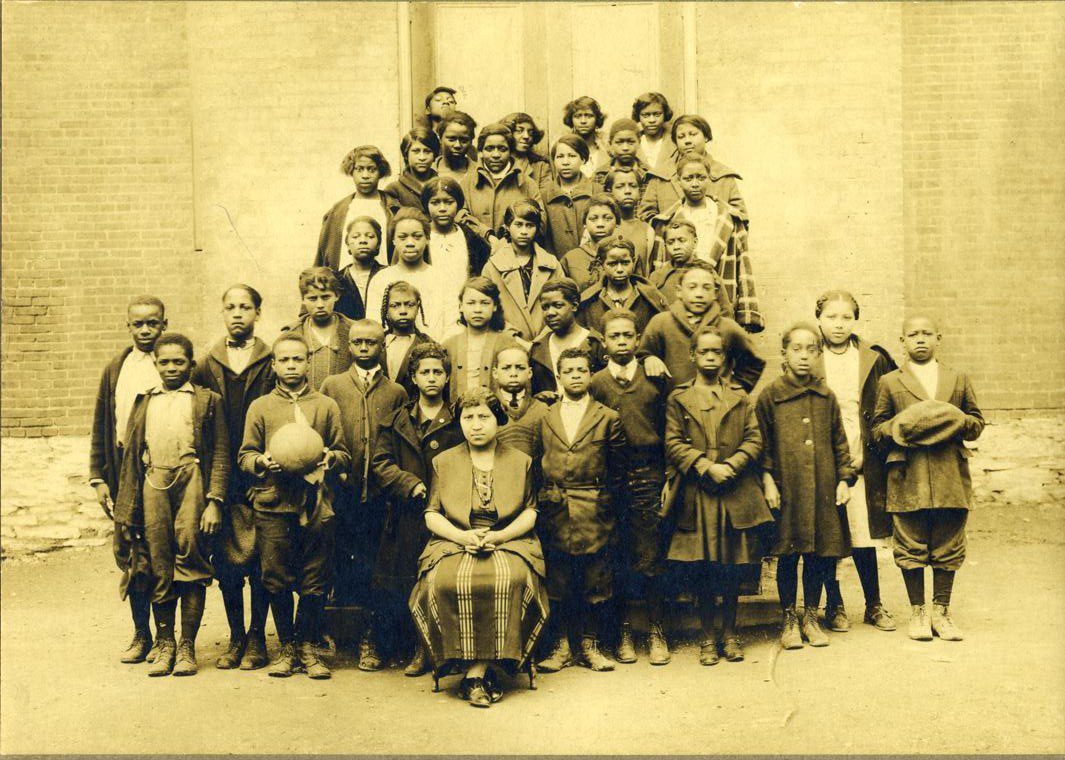
The South Bentz Street School was the first black elementary school in Frederick. Three educators taught grades one through six. Teachers taught two grades at a time. The school operated from the 1880s until 1939, when its students relocated to Lincoln Elementary.
A Brief Excerpt: History of Black Frederick
Text contributed by AARCH (African American Resources – Cultural and Heritage) Society of Frederick, MD
Upon the establishment of Frederick County by European settlers in the 18th century, African descended people were both free and enslaved. Many fugitive Blacks formed Maroon communities with local Native Americans before the arrival of the English. African Americans labored in agriculture, industry, were skilled artisans, and engaged in business. Blacks advanced Frederick County during the colonial era and into the Revolutionary War both on and off the battlefield.
After the war for independence, the population of free Blacks in the Frederick region grew. This inspired greater abolitionist efforts as well as severe laws passed to restrict the freedoms of all African Americans. Despite this, free Blacks established crucial organizations for social, cultural, religious, educational and economic upliftment including the Underground Railroad during the 19th century.
With the Civil War, the status of African Americans changed drastically as over 3,000 Blacks from Frederick fought for freedom in the conflict. The Reconstruction Era in Frederick witnessed an explosion of churches, cemeteries, schools, political associations, and the establishment of Black towns throughout the county.
As Reconstruction ended, the “Jim Crow” era heralded in segregation and the violent treatment of African Americans in Frederick County. This was met by the Frederick Black community with the creation of important institutions to address the needs of African American citizens in medicine, education, religion, culture, economics, politics, and social concerns while simultaneously fighting in both World Wars.
As the Civil Rights Era progressed, Black Frederick residents were exceptionally active in national and local efforts to end segregation and attain equal rights for all. The collective struggle of Black Fredericktonians to ensure justice and equality in Frederick and beyond has continued to the present.
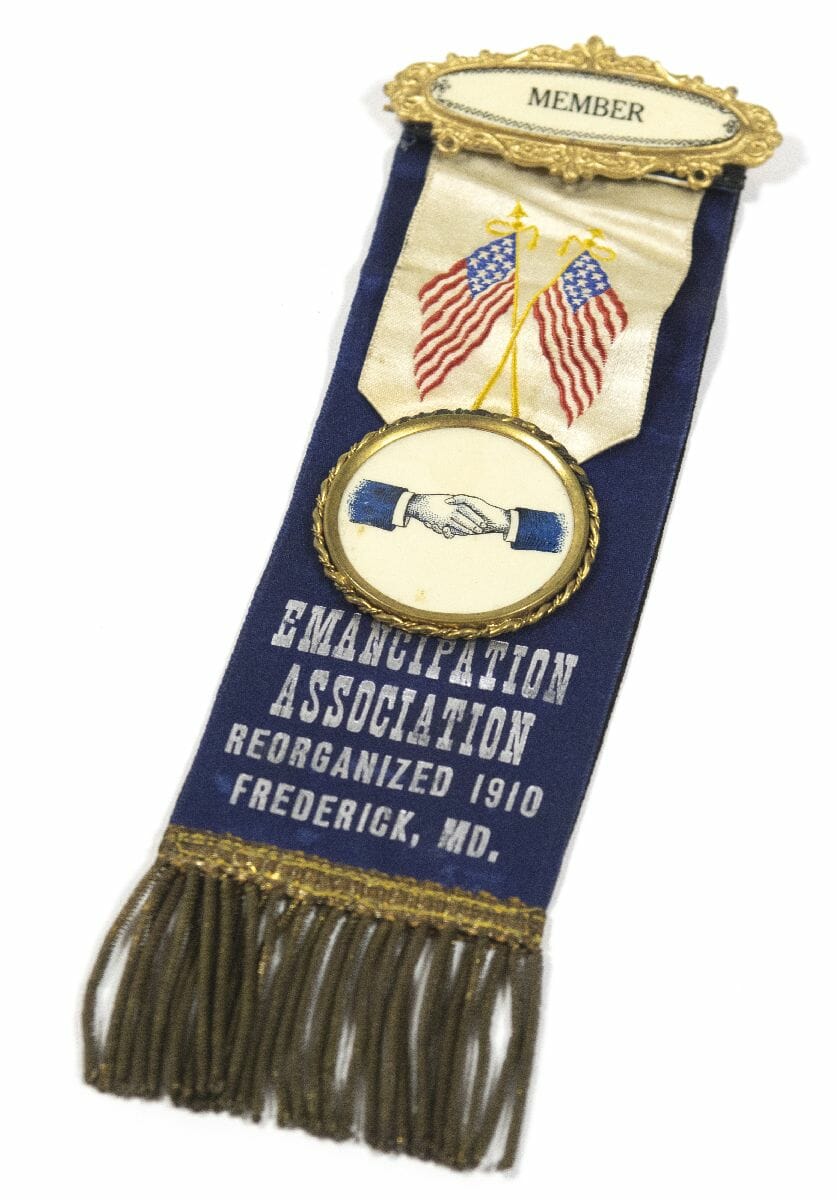
A Brief Excerpt: History of Black Frederick
The Emancipation Association was established in 1890 to commemorate the release of an initial Emancipation Proclamation by Abraham Lincoln on September 22nd. The celebration of Juneteenth started on June 19, 1865, when Union soldiers landed in Galveston, Texas, with news that the Civil War had ended (41 days following the Appomattox surrender) and enslaved people were free. Different states were emancipated at different times. Maryland was emancipated on November 1, 1864. This pin is from 1910. Today, Frederick citizens use Juneteenth to celebrate Emancipation. From 1891 through the 1930s, Frederick’s celebration was held at the Fairgrounds in August.


We were perhaps the first Indian family to settle here. We have witnessed many changes. People from many nations have settled in this welcoming community, giving it an international cultural flavor.
Zakir Bengali was born in Mumbai, India, in 1939. He obtained a Master’s of Science degree in microbiology from the University of Mumbai in 1968. Zakir earned a Ph.D. in biology at the University of Rochester in 1973. He met Kathleen there, and they were married in 1972.
In 1974, they settled in Frederick County, where Zakir joined the National Cancer Institute at Fort Detrick. In 1981, he transferred to the Extramural Program of National Institutes of Health. He retired from NIH in 2006 and joined the Shriner’s Hospitals for Children in Tampa, Florida, as Vice President for Research. In 2009, he retired again and returned to Frederick.
Since 1978, Zakir has been an advocate for education in Frederick County. In 1992, he chaired the Middle School Science Teaching Committee of the Board of Education, and later represented Maryland on the National Science Teaching Standards panel. He served on the Frederick County Board of Education from 2012-2016.
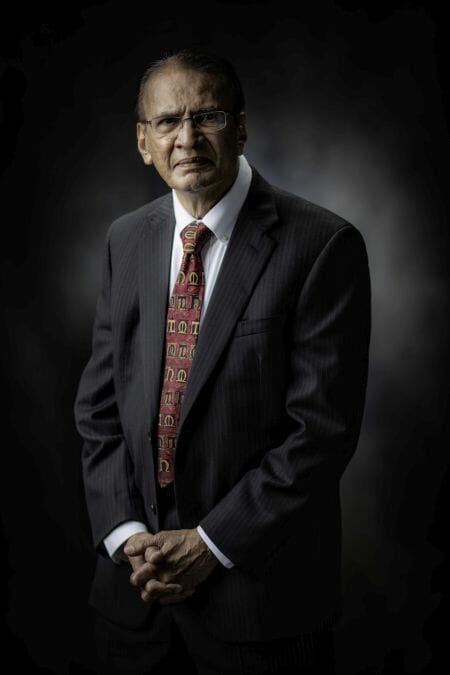
Immigrants have unique needs. Frederick is moving in the right direction, but not fast enough.
Yewande Sofolahan Oladeinde was born in Lagos, Nigeria, in 1985. She speaks fluent English, Nigeria’s official language. Her parents valued education, and she came to the U.S. in 2003 to attend East Stroudsburg University. This was the first time she felt “different.”
Yewande earned a bachelor’s degree in Biology and completed her graduate studies in Behavioral Health at Penn State. She met her husband in Baltimore in 2007. Due to his internship at the National Cancer Institute, they fell in love with Frederick and moved here in 2013.
They have two boys, and she is a research analyst for the federal government in Baltimore. Frederick is very welcoming, but she worries about mothers who don’t have the resources and cannot speak English.

The only limit you have is the one you impose on yourself. Do your best, and your problems are minimized.
Adeyemi Adeoye was born in Nigeria in 1965. A government requirement prevented him from enlisting in the military, so he earned a Bachelor’s degree in marketing and a Master’s degree in business administration. In 1998, he visited his brother in New York and a friend in Frederick. In 2001, he settled in Frederick to give his children a safer environment with excellent schools. He worked in the Frederick County Sheriff’s Office Corrections Bureau from 2003 to 2019, attaining the rank of Sergeant. He served on the Frederick County Human Relations Commission to help solve discrimination issues. He now works in the Loudoun County Sheriff’s Office in Virginia. Yemi became a U.S. citizen in 2007. He connects his family heritage with the Nigerians in Frederick Association.
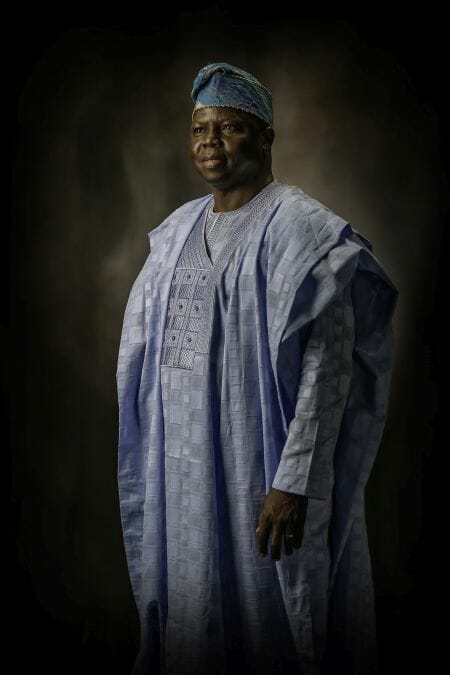
Memory Treasure
Adeyemi “Yemi” Adeoye often wears his clothing from Nigeria. The brown tunic is worn with matching pants as casual attire. His other outfit, the pale green floral tunic (shown left) is for formal events.

Develop skills to be strong and do good for others.
Silvia Muñoz Moreyra was a 30-year-old attorney in Lima, Perú, when she left to live in Frederick. She wanted opportunities for her sixteen-year-old son. Silvia learned English through the Literacy Council. It transformed her and Frederick has always supported her.
Silvia became a U.S. citizen in 2014. She is in Georgetown Law School and helps parents communicate with teachers and professors.
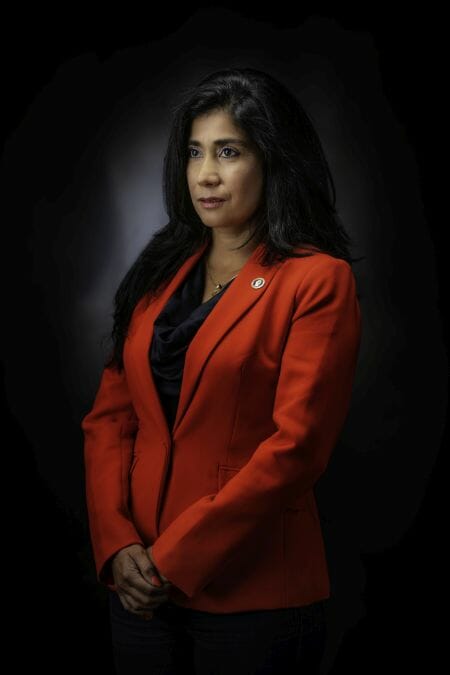
I love Frederick. Everything is much easier here.
Vanda Yamkovenko was born in Siberia in 1956 and is Ukrainian. Her father was sent to Siberia, then part of the Soviet Union. Her mother, who was pregnant with Vanda, followed him. Vanda lived with her grandmother’s sister, who had been deported to Siberia when Stalin was in power.
From 1998 to 2005, Vanda made many job-related trips to the U.S. In 2017, she and her husband settled in Frederick to house-sit for her son, who left local employment to work for Facebook in California. While she had often visited the U.S. and is fluent in English, this transition was challenging.
Vanda is grateful that her son prepared a book of instructions to help her buy a phone, receive health care and find work. Her husband is an artist and exhibits at the Delaplaine Arts Center. Vanda is employed by the Asian American Center.

Face adversity and move on. Your kids watch how you handle life.
Rita Materna Hubbard was born in Wiesbaden, Germany, in 1949. Her family moved to Washington, D.C., in 1953. Her father was a U.S Army officer, and her mother was a German citizen. Their new neighbors didn’t like Rita and her mother because they were Germans. Rita loved her parents, but they were racists. Rita has always had African American and Jewish friends. She is appalled by the hatred of the past and today.
Rita married her husband in 1970. They had four children and divorced in 1989. She and her children moved to Frederick, and everyone worked to pay the bills. They now appreciate giving back to their community in Charles Town, West Virginia.

Memory Treasures
Rita Hubbard’s emigration from Germany today is very different from the experiences German immigrants had when arriving in Frederick in the 1750s. The early German settlers had no birth certificates and there was very little organization. Rita’s birth certificate is from Germany, and indicates her birth in Germany on 12 November, 1949.
These photographs were taken around 1953. (Click for a larger view) This street scene was from Wiesbaden, Germany, Rita’s birthplace. These pictures of Rita with her mother and father (a US Army Soldier) were taken in Washington, D.C. when they first moved in 1953.
The Certificate of Naturalization proves that Rita obtained U.S. citizenship through naturalization in 2017. It indicates that she was not born in the U.S. and voluntarily became a U.S. citizen. The process requires an application, an interview, an English language test, and a civics test.
You have to work hard. Nothing is easy. Nothing is impossible. Frederick is my home.
Paola Bonarriva moved to the U.S. from Lima, Perú, in 2001 to pursue a better future. She has no regrets. Finding decent work was difficult, because she was alone and did not speak the language. She began taking English classes, and her boyfriend from Lima joined her. The experience made her strong. They married and have three sons.
While living in Gaithersburg, they obtained Green Cards and decided to buy a house. They researched the best schools and picked Frederick. They are now U.S citizens. This country has given them many opportunities to grow as adults, professionals, and parents. Paola finds Frederick to be very inclusive and diverse. She became a real estate agent due to the positive experience she received in moving here.

Chen Chiang turned 92 in 2020, and speaks minimal English. He left Taiwan, where he worked as a police officer, to join his sister in Maryland. His family soon followed.
In Hagerstown, he could find work only at Burger King, in 1974. Chen moved to Frederick in 1983 and decided to open his own business, now called China Garden. He wanted to share his passion for Asian cuisine with the community.
For years, China Garden placed #1 in Frederick Magazine’s “Best of the Best.”
He had a great team and wonderful customers who became friends. He taught his family to give back to the community. Chen loves to cook, feed people, and treat guests as family. One of his most enjoyable moments is to see multi generations dine in the restaurant.
China Garden had a fire in 2019, and the family hopes to reopen in the summer of 2021.
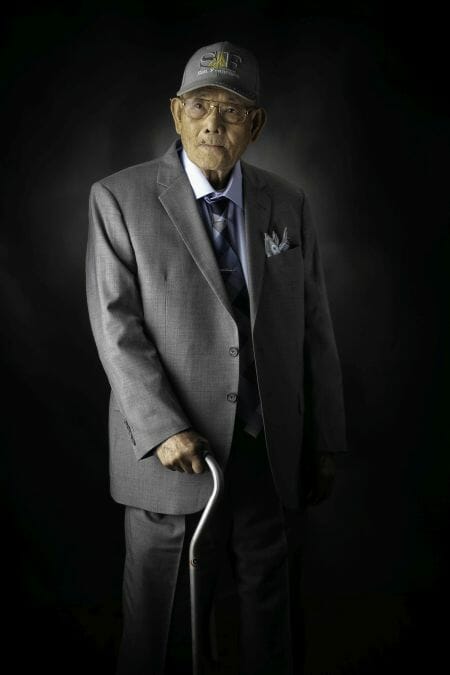
Memory Treasures
Chen Chiang was a police officer in Taiwan before he came to the U.S. This color photograph shows Chen in front of his restaurant China Garden in Frederick. This newspaper clipping from the Frederick News-Post announces the opening of China Garden, February 12, 1992. (A detail of the article appears on click)
Many immigrants feel shame and fear from their experiences. I was given many opportunities that others were not.
Claudia Hernandez was born in Washington, D.C. in 1987. Her parents and grandparents left El Salvador to escape civil unrest. Her parents moved to Thurmont in 2003. She was seen as an outcast in school. She graduated from Thomas Johnson High School and had her son David a week later. With her mother’s help, she enrolled in Frederick Community College.
She graduated from the Universities at Shady Grove with a B.A. in Psychology in 2010 and later earned a master’s degree. Claudia married David’s father and had another son. They now live in Frederick, where she is the Coordinator of Family Engagement and Partnerships with Frederick County Public Schools and is a licensed therapist in a private practice.
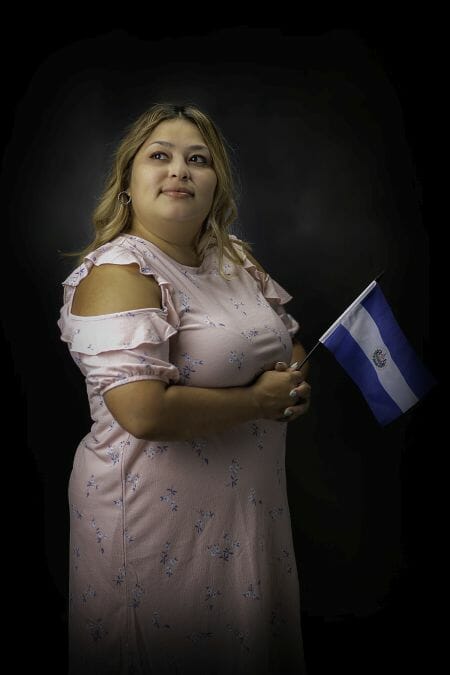
When I took my citizenship oath, I did not cry. A lot of people were escaping from a dictatorship or other pressures, but I had a wonderful childhood.
Elisa Garza is from Chihuahua, Mexico. In 1967, she earned her nursing degree and went to work in an Illinois hospital, where she met her husband. After her contract ended, she returned home, and they were married. They moved to Michigan and eventually settled in Walkersville.
Their neighbors welcomed them immediately, and their children enjoyed school. Elisa worked as a nurse until retiring. She now serves as a Frederick Memorial Hospital medical interpreter, a job she loves. With their children now grown, Elisa understands the pain her family experienced when she left Mexico. The couple eventually will join family members in Texas.
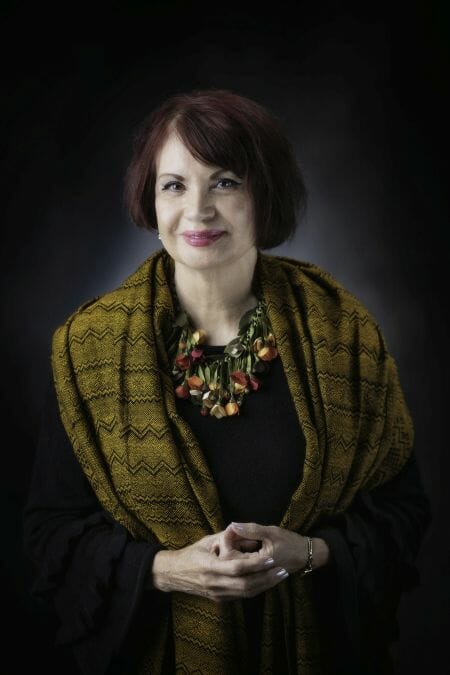
Freedom is not free — it’s very precious. Frederick has a lot of history. Our history, Frederick’s history, is strong, and we need to respect it as well as our own cultural history. How do we bring that together? First and foremost with humanity. I hope that Fredricktonians will appreciate the history of the past and celebrate the commonalities and the differences.
Elizabeth Chung, Executive Director Asian American Center
Elizabeth Chung was born in 1950 in Hong Kong, now part of China. Her father believed that education was very important. Her brother attended school in London, and Elizabeth attended the University of Hawaii in Honolulu. She and her brother were the first siblings to leave home. The experience induced fear and anxiety, but they were inspired by Dr. Martin Luther King, Jr. and President John F. Kennedy.
Elizabeth wanted to follow in the footsteps of her father and grandfather, who were doctors who practiced traditional Chinese medicine. The University of Hawaii taught only Western medicine, so Elizabeth studied public health. She gained additional education at Penn State University, where she met her husband, also from China. Elizabeth now serves as Executive Director of the Asian American Center and chairs the Maryland Community Health Resources Commission.
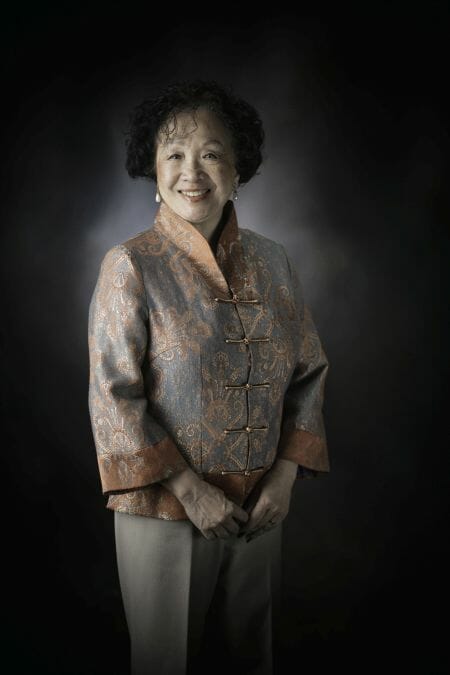
Many Americans think we’re all Mexicans. Nicaragua is a melting pot with people of Asian, African and European descent. Our mission at Centro Hispano is to educate and support immigrants of all ethnicities and faiths.
Maria-Teresa Shuck was born in Washington, D.C., in 1959. Her father was Italian, and her mother is Nicaraguan. They returned to Nicaragua in 1967. Both parents worked for American companies. Her school friends had different nationalities, faiths and social status. It was a good life, but there was poverty, earthquakes, and civil war.
At age 18, she and her sister, age 10, boarded one of the last flights to the U.S. out of Managua. Maria speaks fluent English and could always find excellent employment. She and her husband have three sons and have lived in Frederick County for 30 years. Maria co-founded Centro Hispano in 2006 and is the Executive Director now.
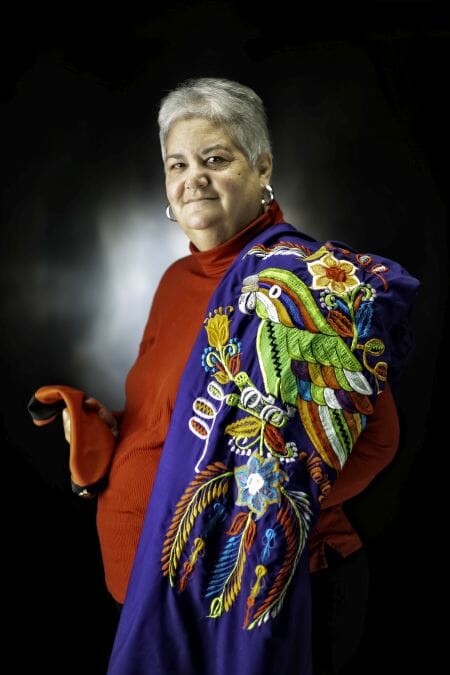
In some ways, my body is in Frederick, but my mind is in El Salvador. I would like to go back someday, but that is not a reality.
Jose Perez grew up in El Salvador with 12 children. They had no running water or electricity. His father visited the U.S. many times and encouraged him to move there. Jose wanted to be a farmer in El Salvador. With the civil unrest, living in America was the safest choice, and he wanted to help his family. In 1980, at age 18, Jose moved to Washington, D.C. He worked as a dishwasher and learned all aspects of restaurant management.
In 1991, Jose and two friends bought the El Mariachi Restaurant in Rockville. They now own restaurants in Maryland, Virginia, Delaware and Florida. Jose has owned and managed the Mexicali Cantina in Frederick for nearly 20 years. He opened Cacique in 2004.
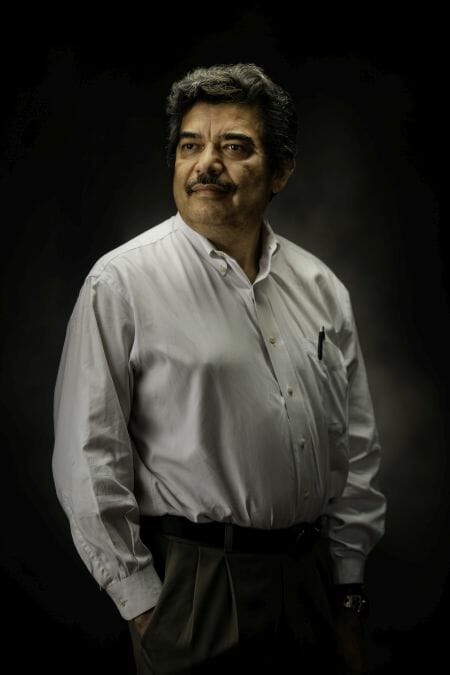
Benjamin Chepkoit was born in Kabarnet, Kenya, in 1962. His father (Wilson, school principal), mother (Esther, housewife), and nine siblings spoke the tribal language, Kalenjin, and lived in the arid Kerio Valley. He tended goats and cows, gathered firewood, and fetched water 15 miles away.
After graduating from Kabarak High, Ben worked as a banker. In 1986, his village raised 186,000 Kenyan shillings ($1,860) to advance his education. He enrolled in Southeastern University, Washington, D.C., in 1987, and lived in an apartment with his wife and three brothers. After earning a few Ph.D.s, he worked in the Washington, D.C. area, California, the Middle East, and Kenya. Ben and his family live in Frederick. He is CEO of his own companies, Optima Business, Shiloh Healthcare, and A Caring Place. He is a volunteer chairman of ASIS Community nonprofit that educates poor Kenyan youths.
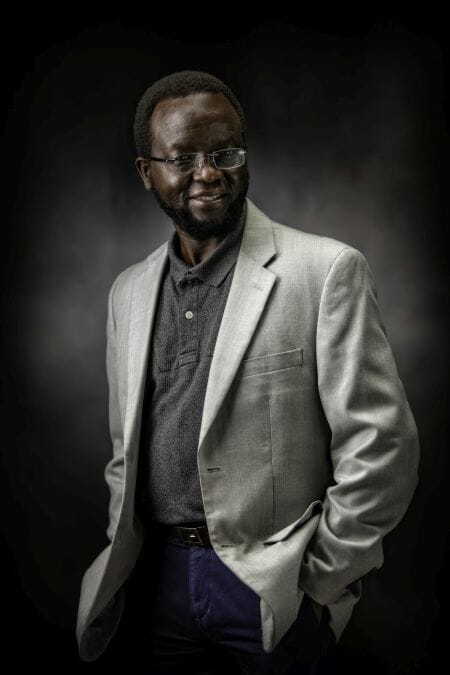
Memory Treasures
Benjamin Chepkoit is proud of his Kenyan roots, shown through the small Kenyan flag, bracelet, and magnet in the shape of the country. The shield and figures represent his tribe, the Kalenjin. He is also proud of his father, Wilson, a school teacher and community leader up until his death in 2019.
Always hold on to your faith, take one step at a time, and be proud of who you are, where you came from, and be a good citizen. Your heritage does not change.
Maria Herrera, Executive Director, Spanish Speaking Community of Maryland
Maria Herrera was born in Havana, Cuba, in 1959. Her father was imprisoned under Castro and released. Her parents petitioned to migrate to the U.S. since they were outcasts. Maria came to the U.S. as a refugee with three changes of clothing. She sold tamales to neighbors to help the family survive.
Her father started the Spanish Speaking Community of Maryland nearly 50 years ago. The nonprofit organization provides resources and guidance to immigrants, and partners with other organizations. Today, Maria is Executive Director. Maria says that Frederick is amazing. People give their hearts and souls to help others.

My dream is that my daughter can be a great woman. In the U.S., that is possible.
Andrea Zalaya is from El Salvador. Her family was not wealthy, yet she never felt deprived. She experienced civil unrest, and that made her strong.
Her mother-in-law convinced Andrea, her husband, and their three-year-old daughter to move to Frederick. In 2014, Andrea divorced her husband and returned to El Salvador.
In 2017, she returned to Frederick to expand her daughter’s opportunities.
Andrea appreciates Frederick’s many cultures, old and new buildings, and seasons. Polite peoplemake her feel welcome. Her daughter has adapted well. Andrea makes sure that she celebrates her roots.
Andrea works at Centro Hispano, helping Hispanics with paperwork. She cleans houses on weekends.
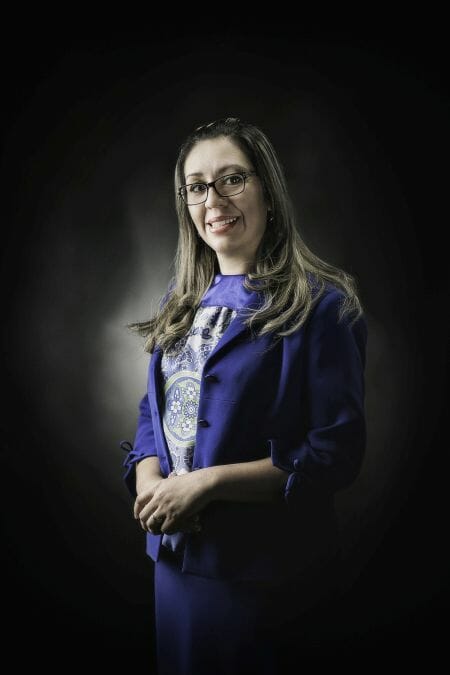
Oluwabukola Christianah Oke was born in Lagos, Nigeria, in 2002, and arrived in Frederick in 2017. Her mother and siblings followed in 2019. Her father has been here for 10 years. Oluwabukola was very nervous at first. She thought she might be bullied, but people have been really friendly. Now she helps her family adjust. They attend the Redeemed Church of Christ. Members are from different countries. She loved her American Studies class. Now she can verify what her family sees on television based on what she was taught in school.



